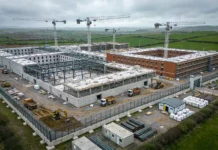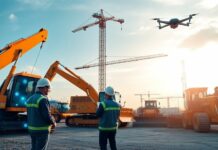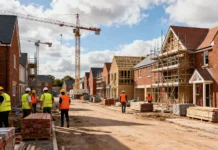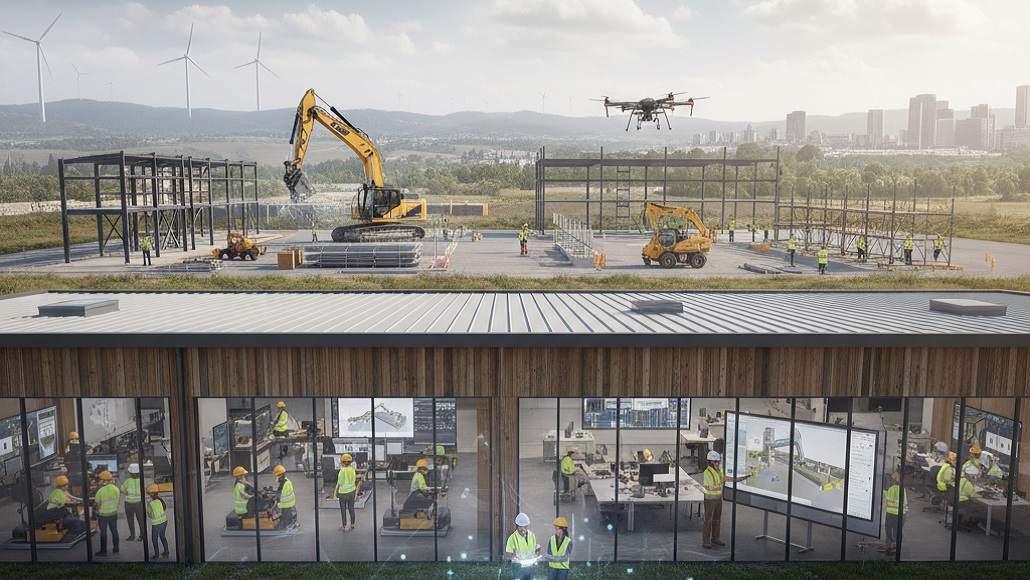The Construction Industry’s Carbon Reckoning
The built environment accounts for approximately 39% of global energy-related carbon dioxide emissions, with construction activities and building operations representing the largest contributors to atmospheric carbon accumulation. This sobering reality has catalyzed unprecedented industry transformation. Decarbonization in construction has transitioned from environmental aspiration to business imperative as regulatory frameworks tighten, investor pressure intensifies, and market demand for sustainable development accelerates.
The construction sector stands uniquely positioned to drive global emissions reductions. Unlike energy or transportation sectors heavily dependent on technological breakthroughs still under development, construction possesses existing technologies enabling substantial near-term emissions reduction. Material innovations, process improvements, and design strategies already available can cut embodied carbon by 50% or more compared to conventional approaches. The challenge lies in systematic adoption rather than innovation limitations.
Understanding Construction’s Carbon Footprint
Embodied and Operational Emissions
Construction carbon emissions divide into two primary categories. Embodied carbon encompasses emissions generated during material extraction, manufacturing, transportation, and construction phases. Operational carbon represents emissions from building energy consumption throughout facility lifespans. While operational emissions traditionally dominated lifecycle assessments for long-occupied buildings, embodied carbon increasingly comprises substantial portions of total emissions particularly as operational systems improve through efficiency measures.
Material production generates the largest embodied carbon component. Cement manufacturing alone produces approximately 8% of global carbon dioxide emissions. Steel production contributes similarly significant volumes. Traditional concrete and steel dominate construction precisely because of economic efficiency; their environmental costs remained externalized historically. Contemporary net-zero construction approaches internalize these externalities, selecting materials based on total lifecycle environmental impact rather than initial cost alone.
Construction processes themselves generate substantial emissions through equipment operation, temporary infrastructure, and site logistics. Diesel-powered machinery, concrete trucks, and support equipment create significant carbon footprints during construction phases typically lasting months or years. Increasingly, contractors recognize that construction phase emissions represent optimization opportunities enabling meaningful reductions.
Policy Frameworks Driving Decarbonization
Regulatory Evolution and Compliance Requirements
Forward-thinking jurisdictions implemented regulations mandating embodied carbon reductions. The European Union’s revised Energy Performance of Buildings Directive requires consideration of whole-lifecycle greenhouse gas emissions. Swedish regulations established carbon budgets for buildings similar to energy budgets, fundamentally changing design priorities. These regulatory pioneers create market conditions rewarding low-carbon approaches while penalizing conventional practices.
Building rating systems including LEED, BREEAM, and Living Building Challenge increasingly emphasize embodied carbon reduction. While not regulatory, these voluntary standards shape market expectations particularly among sophisticated institutional clients. Projects targeting high ratings compete based partly on carbon performance, creating market incentives driving innovation.
Carbon pricing mechanisms through cap-and-trade systems or carbon taxes indirectly influence construction by increasing costs of high-emission material production. As carbon prices increase, material economics shift favoring lower-carbon alternatives. Manufacturers respond by improving production processes reducing carbon intensity, creating virtuous cycles where policy mechanisms drive technological innovation.
Public Procurement and Supply Chain Influence
Government procurement policies wield disproportionate market influence given public sector’s substantial construction spending. When public agencies specify low-carbon material requirements or embodied carbon limits, market demand follows. Manufacturers rapidly develop products meeting procurement specifications knowing government contracts represent substantial revenue opportunities. This procurement leverage accelerates market transformation more efficiently than voluntary initiatives.
Infrastructure development policies increasingly integrate carbon objectives. Transportation projects, water systems, and utility infrastructure now factor embodied carbon into project development decisions. Life-cycle cost accounting incorporating carbon pricing demonstrates that initial material cost premiums often prove economically justified when carbon externalities receive appropriate valuation.
Low-Carbon Material Innovation and Substitution
Advanced Concrete Formulations
Concrete’s carbon intensity derives primarily from cement, the binding material comprising 10-15% of concrete volume but generating disproportionate emissions. Supplementary cementitious materials including fly ash, slag, and calcined clay reduce cement requirements while maintaining performance. Geopolymer concrete employing industrial byproducts as primary binders achieves 50-90% embodied carbon reductions compared to conventional formulations.
Carbonated concrete captures carbon dioxide during curing, converting it into stable mineral phases. This negative-emissions material removes atmospheric carbon while providing structural performance. While currently expensive, scaling these production processes promises dramatic cost reduction making carbon-negative concrete economically competitive within years.
Fiber reinforcement innovation reduces concrete thickness requirements enabling thinner, lighter structures reducing material volume and associated emissions. Advanced reinforced concrete designs optimize load paths minimizing material waste while maximizing structural efficiency. These design innovations combined with material improvements achieve cumulative decarbonization effects exceeding any single intervention.
Engineered Timber and Mass Timber Solutions
Engineered timber products offer exceptional carbon credentials through carbon sequestration—trees absorb carbon dioxide during growth, storing it in wood fiber. Using timber for structural applications converts forests into carbon storage rather than consuming stored carbon. Sustainably managed forests enable perpetual carbon sequestration, making timber renewable in ways cement and steel cannot match.
Cross-laminated timber, glulam, and laminated veneer lumber technologies enable tall wood structures with performance comparable to conventional materials. Modern tall wood buildings reaching 30+ stories demonstrate that timber enables high-performance construction previously assumed requiring concrete and steel. As timber technology matures and building codes expand timber application scope, wood becomes increasingly competitive alternative to conventional materials.
Reclaimed and salvaged timber provides carbon benefits exceeding sustainably harvested new timber. Reusing architectural timber from demolished structures avoids both new timber production emissions and demolition waste. Supply chains supporting salvaged timber extraction and reuse continue professionalizing, improving availability and reliability.
Alternative Materials and Emerging Solutions
Mycelium-based composites employing fungal networks as binding agents offer low-carbon, compostable structural materials. Still in development stages, these biological materials promise revolutionary approaches to construction materials. Similarly, algae-based binders and seaweed-reinforced composites represent emerging alternatives with negligible carbon footprints.
Recycled plastic lumber and composite materials divert waste streams from landfills while reducing virgin material extraction. While performance characteristics differ from conventional materials, specific applications where plastic composites excel continue expanding. Integration in secondary structural elements and non-critical applications enables broader adoption.
Design Strategies for Minimum Carbon
Life-Cycle Design and Optimization
Net-zero construction requires design optimization considering full material lifecycles. Designs minimizing material volume through efficient load paths directly reduce embodied carbon. Lightweight structures requiring less material inherently generate lower emissions while reducing operational energy for heating and cooling.
Structural design strategies including load distribution optimization, span reduction, and material efficiency represent fundamental approaches to embodied carbon reduction. Advanced structural analysis software identifies optimal configurations minimizing material while maintaining required capacity. These computational design approaches require additional upfront analysis effort generating lifetime carbon benefits.
Durability and longevity considerations prove critical for carbon reduction. Structures designed for 100-year service lives generate lower amortized embodied carbon than those lasting 50 years. Material selection favoring durability, design standards exceeding minimum codes, and construction quality supporting extended service life collectively ensure carbon investments in building delivery yield benefits throughout operational lifespans.
Modular and Prefabricated Design
Prefabrication reduces construction waste while optimizing material utilization through factory controls. Off-site manufacturing enables precise material quantities minimizing excess compared to site-built approaches generating substantial waste. Modular design enabling disassembly supports future material recovery, extending effective service life and deferring demolition carbon costs.
Design standardization supporting modular approaches reduces custom material production with associated carbon penalties. Standardized dimensions, specifications, and connection details enable efficient manufacturing and assembly. Secondary material markets developing around standardized components enable recovery and reuse supporting circular economy principles.
Construction Phase Emissions Reduction
Electric Equipment and Renewable Energy
Zero-emission construction equipment powered by batteries or hydrogen fuel cells eliminates on-site fossil fuel combustion. Battery electric compressors, saws, and hand tools already provide viable alternatives to diesel-powered equipment with performance capabilities matching conventional tools. Fleet-scale electrification of concrete trucks, excavators, and mobile cranes represents emerging frontier enabling construction site decarbonization.
Renewable energy powering construction equipment through temporary solar installations or grid electricity from renewable sources enables emissions-free operations. Some leading contractors implement on-site solar systems providing power during multi-month construction projects. Grid decarbonization progressing globally ensures that electrified equipment increasingly operates using clean electricity even without dedicated renewable installations.
Logistics Optimization and Material Efficiency
Construction logistics represent underexplored decarbonization opportunities. Material transportation generates substantial emissions proportional to distance and vehicle fuel intensity. Sourcing materials locally reduces transportation distances and associated carbon. Consolidating material deliveries reduces vehicle trips while increasing load factors improving transportation efficiency.
Just-in-time material delivery reduces on-site storage requirements while minimizing waste from material exposure or handling. Precise coordination between suppliers and construction scheduling enables optimal material flow. Digital material management systems tracking inventory and predicting requirements support efficient logistics while reducing material waste.
Operational Emissions and Building Performance
High-Performance HVAC and Control Systems
Building mechanical systems represent largest operational energy consumers. Advanced HVAC design employing thermal recovery, optimal control algorithms, and demand-responsive ventilation dramatically reduces energy consumption compared to conventional systems. Heat recovery ventilation systems capture waste heat from exhaust air preheating incoming fresh air reducing conditioning requirements.
Digital building control systems continuously optimize mechanical operation based on occupancy, weather, and demand patterns. Machine learning algorithms develop sophisticated understanding of building dynamics enabling predictive controls anticipating heating and cooling requirements. These advanced controls often reduce energy consumption 20-30% compared to conventional thermostatic approaches without occupant comfort degradation.
Renewable Energy Integration
Rooftop solar photovoltaic systems converting building surfaces into power generation enable net-zero operational performance. Improving photovoltaic efficiency and declining costs make solar economically advantageous in most locations. Battery storage systems store solar energy for nighttime use or peak-demand periods enabling buildings to minimize grid electricity consumption.
Wind turbines and other renewable sources supplement solar generation in appropriate locations. Geothermal systems efficiently provide heating and cooling using stable subsurface temperatures. Heat pump technologies capture ambient air energy even at low temperatures enabling efficient heating. Combining multiple renewable sources and efficiency measures enables fully decarbonized operational energy.
Implementation Challenges and Market Evolution
Widespread decarbonization adoption faces persistent obstacles. Material cost premiums for low-carbon alternatives create initial budget pressures despite lifecycle economic justification. Developer shortsightedness prioritizing initial cost over lifecycle performance perpetuates conventional practices. Financing structures failing to account for operational savings limit investment in efficiency measures with superior long-term economics.
Workforce expertise and supply chain maturity for low-carbon materials remain underdeveloped in many regions. Designers trained in conventional approaches often lack knowledge of alternative material application. Contractors unfamiliar with prefabrication processes hesitate adopting approaches promising efficiency gains but requiring operational changes.
Overcoming these obstacles requires coordinated action across multiple constituencies. Policy frameworks establishing carbon requirements and pricing create market signals. Financial mechanisms including green bonds and performance-based lending reward carbon reduction investments. Workforce development programs prepare industry personnel for evolving technologies. Industry leadership demonstrating net-zero achievement provides proof-of-concept reducing perceived risk.
Decarbonization in construction represents not future requirement but present imperative. Regulatory evolution, investor pressure, and market demand increasingly penalize carbon-intensive practices while rewarding sustainable alternatives. Organizations embracing net-zero construction position themselves advantageously as markets inevitably transition toward decarbonized operations.





























